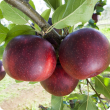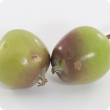Crops
The Department of Primary Industries and Regional Development continues to support the growth and international competitiveness of all crop industries in Western Australia.
With a 2400 kilometre span from its tropical north to its temperate south, WA supports a broad range of cropping industries from rain-fed winter cereals through to irrigated horticultural crops.
In the 2012/13 year the WA cropping industries exported a total of $3.9 billion which comprised: $3.1 billion of cereals, $859 million of pulses, pastures and oilseeds, $142 million of horticultural crops. The major contributors to these exports were wheat ($2.7 billion), canola ($756 million), barley ($377 million), lupins ($42 million), carrots at $48 million, oats ($12 million), and strawberries at $5.5 million.
Articles
Pages
- « first
- ‹ previous
- 1
- 2
- 3
Filter by search
Filter by topic
- Horticulture (26) Apply Horticulture filter
- (-) Remove Fruit filter Fruit
- (-) Remove Pome fruit filter Pome fruit
- Pests, weeds & diseases (13) Apply Pests, weeds & diseases filter
- Pests (12) Apply Pests filter
- Stone fruit (11) Apply Stone fruit filter
- Pest insects (10) Apply Pest insects filter
- Climate, land & water (6) Apply Climate, land & water filter
- Grapes & wine (4) Apply Grapes & wine filter
- Water (4) Apply Water filter
- Water management (4) Apply Water management filter
- Production & postharvest (4) Apply Production & postharvest filter
- Minor fruits (3) Apply Minor fruits filter
- Diseases (2) Apply Diseases filter
- Mites & spiders (2) Apply Mites & spiders filter
- Irrigation (2) Apply Irrigation filter
- Climate change (2) Apply Climate change filter
- Citrus (2) Apply Citrus filter
- Climate & weather (2) Apply Climate & weather filter
- Plant nutrition (1) Apply Plant nutrition filter
- Plant biosecurity (1) Apply Plant biosecurity filter
- Potatoes (1) Apply Potatoes filter
- Vegetables (1) Apply Vegetables filter
- Wine grapes (1) Apply Wine grapes filter
- Weeds (1) Apply Weeds filter
- Nursery & cutflowers (1) Apply Nursery & cutflowers filter
- Table grapes (1) Apply Table grapes filter
- Food safety (1) Apply Food safety filter
- Biosecurity & quarantine (1) Apply Biosecurity & quarantine filter
- Biosecurity (1) Apply Biosecurity filter
- Agribusiness Food & Trade (1) Apply Agribusiness Food & Trade filter
- Breeding & varieties (1) Apply Breeding & varieties filter
- Fertiliser (1) Apply Fertiliser filter
- Fungi (1) Apply Fungi filter
- Food & beverages (1) Apply Food & beverages filter
- Grains (1) Apply Grains filter









